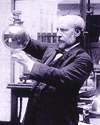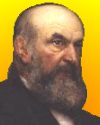 | TODAY IN SCIENCE HISTORY
NEWSLETTER - 5 JUNE |
 On 5 Jun 1878, liquid air obtained at a temperature of -192�C was exhibited by Professor James Dewar at the Royal Institution, London. For several little known, but interesting, discoveries related to air, read A Summary of Scientific Discoveries and Inventions Relating to the Air from Haydn's Dictionary of Dates, 1904. There you can learn about such novelties as an air-driven clock, air-engine for railway carriages or the more familiar air brush (Aerograph) used by artists. On 5 Jun 1878, liquid air obtained at a temperature of -192�C was exhibited by Professor James Dewar at the Royal Institution, London. For several little known, but interesting, discoveries related to air, read A Summary of Scientific Discoveries and Inventions Relating to the Air from Haydn's Dictionary of Dates, 1904. There you can learn about such novelties as an air-driven clock, air-engine for railway carriages or the more familiar air brush (Aerograph) used by artists.
|
 On 5 Jun 1819, John Couch Adams was born, the English astronomer and mathematician, one of two people who independently discovered a new planet. Tom Standage (author of The Victorian Internet) wrote a book subtitled A Story of Astronomical Rivalry and the Pioneers of Planet Hunting describing the activity leading up to the discovery. (Giving its main title here would give away the answer to a question lower down this page!) On 5 Jun 1819, John Couch Adams was born, the English astronomer and mathematician, one of two people who independently discovered a new planet. Tom Standage (author of The Victorian Internet) wrote a book subtitled A Story of Astronomical Rivalry and the Pioneers of Planet Hunting describing the activity leading up to the discovery. (Giving its main title here would give away the answer to a question lower down this page!)
Unfortunately for Adams, he had a rival. The French astronomer Urbain Le Verrier calculated the planet's position shortly after Adams -- and an international race to spot the planet itself began.
Available Used from $0.01 (as of time of writing).
For picks from earlier newsletters, see the Today in Science Science Store home page. | |
 | "The most important and urgent problems of the technology of today are no longer the satisfactions of the primary needs or of archetypal wishes, but the reparation of the evils and damages by technology of yesterday. " - Dennis Gabor, Hungarian-British physicist and electrical engineer (born 5 Jun 1900)  |
 | "I long to speak out the intense inspiration that comes to me from the lives of strong women. They have made of their lives a great adventure." - Ruth Benedict, English geologist, palaeontologist and clergyman (born 5 Jun 1887)  |
| "But shall gravity be therefore called an occult cause, and thrown out of philosophy, because the cause of gravity is occult and not yet discovered? Those who affirm this, should be careful not to fall into an absurdity that may overturn the foundations of all philosophy. For causes usually proceed in a continued chain from those that are more compounded to those that are more simple; when we are arrived at the most simple cause we can go no farther ... These most simple causes will you then call occult and reject them? Then you must reject those that immediately depend on them." - Roger Cotes, British mathematician and astronomer who edited the second edition of Newton's Principia (died 5 Jun 1716))  |
| Before you look at today's web page, see if you can answer some of these questions about the events that happened on this day. Some of the names are very familiar. Others will likely stump you. Tickle your curiosity with these questions, then check your answers on today's web page. |
 |  Dennis Gabor was born 5 Jun 1900. Hungarian-born British electrical engineer who won the Nobel Prize for Physics in 1971 for his invention, a system of lensless, three-dimensional photography that has many applications. He first conceived the idea in 1947 using conventional filtered-light sources. Because such sources had limitations of either too little light or too diffuse, his idea was not commercially feasible until the invention of the laser (1960), which amplifies the intensity of light waves. Dennis Gabor was born 5 Jun 1900. Hungarian-born British electrical engineer who won the Nobel Prize for Physics in 1971 for his invention, a system of lensless, three-dimensional photography that has many applications. He first conceived the idea in 1947 using conventional filtered-light sources. Because such sources had limitations of either too little light or too diffuse, his idea was not commercially feasible until the invention of the laser (1960), which amplifies the intensity of light waves.
 What was his invention? What was his invention? |
 |  John Couch Adams, born 5 Jun 1819, was a British mathematician and astronomer who independently discovered a planet. On 3 Jul 1841, Adams had entered in his journal: "Formed a design in the beginning of this week of investigating, as soon as possible after taking my degree, the irregularities in the motion of Uranus ... in order to find out whether they may be attributed to the action of an undiscovered planet beyond it. John Couch Adams, born 5 Jun 1819, was a British mathematician and astronomer who independently discovered a planet. On 3 Jul 1841, Adams had entered in his journal: "Formed a design in the beginning of this week of investigating, as soon as possible after taking my degree, the irregularities in the motion of Uranus ... in order to find out whether they may be attributed to the action of an undiscovered planet beyond it.  Which planet did he discover? Which planet did he discover? |
 |  Augustus Edward Hough Love (1863-1940) was a British geophysicist and mathematician who discovered a major type of earthquake wave that was subsequently named for him. Love assumed that the Earth consists of concentric layers that differ in density and postulated the occurrence of a seismic wave confined to the surface layer (crust) of the Earth which propagated between the crust and underlying mantle. His prediction was confirmed by recordings of the behaviour of waves in the surface layer of the Earth. Augustus Edward Hough Love (1863-1940) was a British geophysicist and mathematician who discovered a major type of earthquake wave that was subsequently named for him. Love assumed that the Earth consists of concentric layers that differ in density and postulated the occurrence of a seismic wave confined to the surface layer (crust) of the Earth which propagated between the crust and underlying mantle. His prediction was confirmed by recordings of the behaviour of waves in the surface layer of the Earth.
 What did he propose could be determined using measurements of Love waves? What did he propose could be determined using measurements of Love waves? |
 |  On 5 Jun 1981, an epidemic disease was briefly described by Dr. Michael Gottlieb in the newsletter of the U.S. Centers for Disease Control. This was the first notice to be published on the disease. On 5 Jun 1981, an epidemic disease was briefly described by Dr. Michael Gottlieb in the newsletter of the U.S. Centers for Disease Control. This was the first notice to be published on the disease.
 By what name is the disease now known? |
 |  On 5 Jun 1783, the first hot-air balloon was flown for ten minutes by two French brothers at their home town of Annonay, France. On 5 Jun 1783, the first hot-air balloon was flown for ten minutes by two French brothers at their home town of Annonay, France.
 Can you name these men? |
 |  On 5 Jun 1977, the first personal computers, the invention of Steve Wozniak and Steve Jobs, went on sale. They had the 6502 microprocessor, ability to do Hi-res and Lo-res color graphics, sound, joystick input, and casette tape I/O. They had a total of eight expansion slots for adding peripherials. Clock speed was 1MHz. On 5 Jun 1977, the first personal computers, the invention of Steve Wozniak and Steve Jobs, went on sale. They had the 6502 microprocessor, ability to do Hi-res and Lo-res color graphics, sound, joystick input, and casette tape I/O. They had a total of eight expansion slots for adding peripherials. Clock speed was 1MHz.
 What was the name of this computer? |
When you have your answers ready to all the questions above, you'll find all the information to check them, and more, on the June 5 web page of Today in Science History. Or, try this link first for just the brief answers.
Fast answers for the previous newsletter for June 4: Sir Christopher Cockerell; the Circum-Pacific belt; 3,028 feet; the century including the year 780 BC; he was six years old.
|
 If you enjoy this newsletter, the website, or wish to offer encouragement or ideas, please send feedback by using your mail reader Reply button. If you enjoy this newsletter, the website, or wish to offer encouragement or ideas, please send feedback by using your mail reader Reply button. |
--
If you do not want to receive any more newsletters,
Unsubscribe To update your preferences and to unsubscribe visit
this link 


 On 5 Jun 1878, liquid air obtained at a temperature of -192�C was exhibited by Professor James Dewar at the Royal Institution, London. For several little known, but interesting, discoveries related to air, read A Summary of Scientific Discoveries and Inventions Relating to the Air from Haydn's Dictionary of Dates, 1904. There you can learn about such novelties as an air-driven clock, air-engine for railway carriages or the more familiar air brush (Aerograph) used by artists.
On 5 Jun 1878, liquid air obtained at a temperature of -192�C was exhibited by Professor James Dewar at the Royal Institution, London. For several little known, but interesting, discoveries related to air, read A Summary of Scientific Discoveries and Inventions Relating to the Air from Haydn's Dictionary of Dates, 1904. There you can learn about such novelties as an air-driven clock, air-engine for railway carriages or the more familiar air brush (Aerograph) used by artists.


 Dennis Gabor was born 5 Jun 1900. Hungarian-born British electrical engineer who won the Nobel Prize for Physics in 1971 for his invention, a system of lensless, three-dimensional photography that has many applications. He first conceived the idea in 1947 using conventional filtered-light sources. Because such sources had limitations of either too little light or too diffuse, his idea was not commercially feasible until the invention of the laser (1960), which amplifies the intensity of light waves.
Dennis Gabor was born 5 Jun 1900. Hungarian-born British electrical engineer who won the Nobel Prize for Physics in 1971 for his invention, a system of lensless, three-dimensional photography that has many applications. He first conceived the idea in 1947 using conventional filtered-light sources. Because such sources had limitations of either too little light or too diffuse, his idea was not commercially feasible until the invention of the laser (1960), which amplifies the intensity of light waves.  What was his invention?
What was his invention?
 John Couch Adams, born 5 Jun 1819, was a British mathematician and astronomer who independently discovered a planet. On 3 Jul 1841, Adams had entered in his journal: "Formed a design in the beginning of this week of investigating, as soon as possible after taking my degree, the irregularities in the motion of Uranus ... in order to find out whether they may be attributed to the action of an undiscovered planet beyond it.
John Couch Adams, born 5 Jun 1819, was a British mathematician and astronomer who independently discovered a planet. On 3 Jul 1841, Adams had entered in his journal: "Formed a design in the beginning of this week of investigating, as soon as possible after taking my degree, the irregularities in the motion of Uranus ... in order to find out whether they may be attributed to the action of an undiscovered planet beyond it.  Which planet did he discover?
Which planet did he discover?
 Augustus Edward Hough Love (1863-1940) was a British geophysicist and mathematician who discovered a major type of earthquake wave that was subsequently named for him. Love assumed that the Earth consists of concentric layers that differ in density and postulated the occurrence of a seismic wave confined to the surface layer (crust) of the Earth which propagated between the crust and underlying mantle. His prediction was confirmed by recordings of the behaviour of waves in the surface layer of the Earth.
Augustus Edward Hough Love (1863-1940) was a British geophysicist and mathematician who discovered a major type of earthquake wave that was subsequently named for him. Love assumed that the Earth consists of concentric layers that differ in density and postulated the occurrence of a seismic wave confined to the surface layer (crust) of the Earth which propagated between the crust and underlying mantle. His prediction was confirmed by recordings of the behaviour of waves in the surface layer of the Earth.  What did he propose could be determined using measurements of Love waves?
What did he propose could be determined using measurements of Love waves? 
 On 5 Jun 1981, an epidemic disease was briefly described by Dr. Michael Gottlieb in the newsletter of the U.S. Centers for Disease Control. This was the first notice to be published on the disease.
On 5 Jun 1981, an epidemic disease was briefly described by Dr. Michael Gottlieb in the newsletter of the U.S. Centers for Disease Control. This was the first notice to be published on the disease.  By what name is the disease now known?
By what name is the disease now known?
 On 5 Jun 1783, the first hot-air balloon was flown for ten minutes by two French brothers at their home town of Annonay, France.
On 5 Jun 1783, the first hot-air balloon was flown for ten minutes by two French brothers at their home town of Annonay, France. Can you name these men?
Can you name these men? 
 On 5 Jun 1977, the first personal computers, the invention of Steve Wozniak and Steve Jobs, went on sale. They had the 6502 microprocessor, ability to do Hi-res and Lo-res color graphics, sound, joystick input, and casette tape I/O. They had a total of eight expansion slots for adding peripherials. Clock speed was 1MHz.
On 5 Jun 1977, the first personal computers, the invention of Steve Wozniak and Steve Jobs, went on sale. They had the 6502 microprocessor, ability to do Hi-res and Lo-res color graphics, sound, joystick input, and casette tape I/O. They had a total of eight expansion slots for adding peripherials. Clock speed was 1MHz. What was the name of this computer?
What was the name of this computer? If you enjoy this newsletter, the website, or wish to offer encouragement or ideas, please send feedback by using your mail reader Reply button.
If you enjoy this newsletter, the website, or wish to offer encouragement or ideas, please send feedback by using your mail reader Reply button. 

Δεν υπάρχουν σχόλια:
Δημοσίευση σχολίου